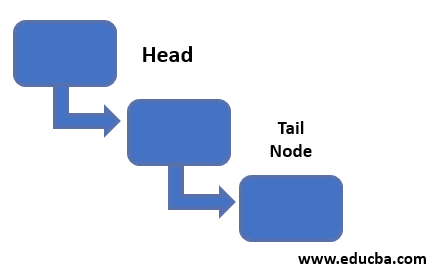Updated March 6, 2023

Introduction to Linked List
The following article provides an outline for Linked List Advantages. Basically, a LinkedIn list can be defined as a data structure where the elements are associated with pointers. In this linked list, a node denotes an element holding a few data info and a pointer that indicates to the next one (node or element).
Its structural representation can be viewed as follows:
The Linked List denotes a dynamic organization consisting of a ‘link’ to the structure, including the succeeding items. It indicates a group of structures well-ordered by the logical links, which are stored being a portion of the data info inside the structure itself but not well-organized by the physical assignment such as an array in the memory.
Various Linked List Advantages
Before going towards the advantages of a linked list, let us see the classifications of a linked list:
- Singly Type Linked List: In this kind of Linked List, each node consists few data along with a pointer to the succeeding node belonging to a similar data type. This is an easy and simple type of Linked List. Here, the node consists of a pointer to the succeeding node defines that the node keeps the address of the succeeding node within a structure. This singly linked list permits traversal of data only in a single way.
- Two-Way or Doubly Linked List: This two-way type of LinkedIn List is a further complex kind of linked list than the previous one where it consists of a pointer to the succeeding and the preceding node in the structure. Hence, it comprises three portions of Linked List working that includes data, a pointer to the succeeding node and, at last, a pointer to the preceding node. Also, this will make us to traverse the doubly linked list as well in a backward direction.
- Circular Linked List: In this circular type of list, the last node consists of the pointer to the initial node of the Linked List. For traversing this circular linked list, a user can start at any node and then traverse the linked list in either forward or backward directions till getting the similar node where it started. Therefore, this circular linked list consists of no start and end nodes.
- Circular Doubly Linked List: This is a two-way circular type of linked list, a bit complex kind containing a pointer to the succeeding and the preceding node in the structure. Here, the difference between the circular doubly linked list and the doubly linked list displays the similarity between a circular linked list with a singly linked list. But in this doubly circular linked list, we cannot find a null value in the preceding field of the initial node.
Some of the main advantages or benefits that the linked list delivers:
- Dynamic Type Data Structure: A linked list is capable of developing and shrinking at the runtime due to the dynamic organization performed by assigning and not assigning memory. Thus, it is not required to provide the linked list with primary size.
- No Wastage of Memory: The Linked List offers achievement of effective memory utilization because the size of this list rise or fall at runtime; hence there is no wastage of memory. Also, there is no requirement for pre-assigning the memory.
- Implementation: The Linear type data structures such as queues and stack are simply executed often by means of a Linked list.
- Insert and Delete Operations: In this linked List, it is easy to perform the insertion and deletion query operations. We do not require to move elements after the operations of inert and delete of an element, but just the address available in the succeeding pointer requires to be modified.
Further, there can be other kinds also like Header Linked List and Multi Linked List.
Few applications of linked list:
- Linked List are implemented to signify and even operate polynomial.
- Hash Tables apply linked List for the purpose of collision resolution.
- It is also used for dialog of any File Requester.
- Linked List is useful to deploy queue, stack, graphs and trees.
- Further, it is used for implementing the symbol table in the creation of the compiler.
Few common variables implemented in linked list process:
- START: It keeps the address of the initial node.
- AVAIL: It preserves the address of the initial free space.
- PTR: This variable is used to point to the node which is presently being retrieved.
- NULL: It denotes the end of the list.
Few disadvantages over linked list uses:
- In a Linked List, we cannot implement the Binary search method.
- The elements of arrays can be randomly retrieved using valid indexes, but we cannot do so with the Linked list elements. This delivers leisurelier search times.
- In comparison to arrays, the Linked List takes more memory space due to the extra field or linked field defining the succeeding pointer.
- In this Linked List, the nodes or, say, elements traversal is quite complex, and to fetch a large node, more time will be required.
- Also, the reverse traversal is too very difficult in a Linked List, but even though it may be simple in a doubly type list, it may consume more additional memory needed for the back pointer, which defines the memory wastage.
Conclusion
We can find different pros and cons related to Linked List data structure when we want a proper design for optimized and scaled programs. While a Linked List is determined, another technique to collect identical data. We can keep elements present in a Linked List everywhere in the memory storage where the memory is assigned at run time only, unlike the array where the memory is assigned at the compile time. Conversely, not like the array, the elements are not present in consecutive memory locations for the period of a linked list. By implementing pointers in Linked List, all nodes included in a Linked List are associated with each other.
Recommended Articles
This is a guide to Linked List Advantages. Here we discuss the introduction and various linked list advantages, respectively. You may also have a look at the following articles to learn more –

